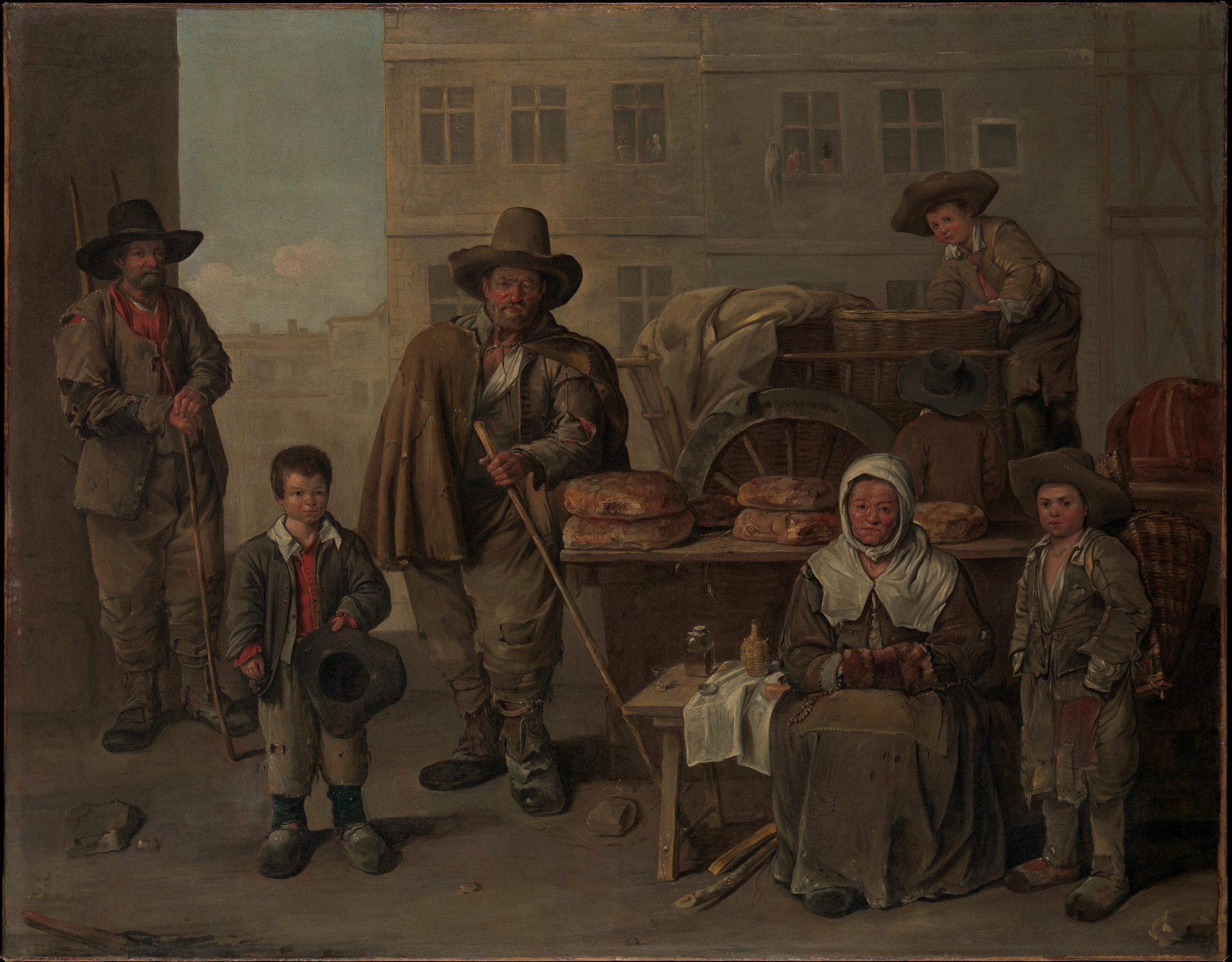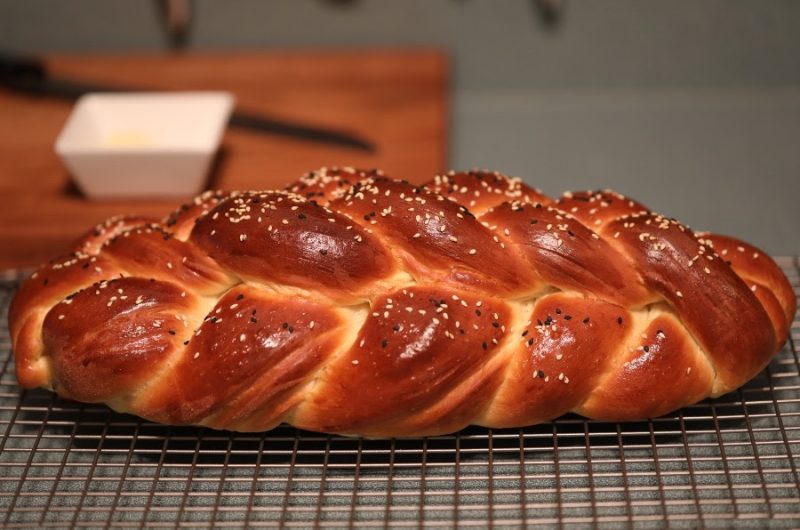
ABOUT THE ART
Michelin, Jean. The Baker’s Cart. 1656. Oil on canvas. 38 3/4 x 49 3/8 in. (98.4 x 125.4 cm). Fletcher Fund, 1927. New York. The Metropolitan Museum of Art.
During the seventeenth century, depictions of peasants and everyday life in rural areas were frequently portrayed in paintings. However, Michelin’s figures, such as a baker with his cart, an elderly woman offering medicinal eau-de-vie, and a boy holding a basket, are situated in an urban environment. Despite being lesser-known than the renowned Le Nain brothers, Michelin’s subjects are similar to theirs. Not much is known about Michelin, but this painting has become a defining piece of his oeuvre since his signature and a date were revealed during a cleaning of the canvas in the late 1920s.
Loaf Mass (St. Peter in Chains) – August 1st
Lammas Day is one of the four quarter-days of the year, marking the day between mid-summer (or the summer solstice) and the autumn equinox. It signals the beginning of early fall, a harvest season for the Northern Hemisphere. Many different cultures celebrate this time of year in various ways, but almost all honor the harvest of grain.
“Lammas” means “loaf mass” and originally referred to a service in which people gave thanks to God for bread. They would bring their loaves to church to be blessed, and some of the loaves would be used for the Eucharist. Some services even included a procession to the local bakery to offer blessings.
Liturgically, Lammas became known as the Feast of St. Peter in Chains. In Acts 12, we read the story of Peter’s imprisonment by Herod, but an angel came and told him to leave. Immediately, his chains fell off, and he followed the angel out through open doors. It is a day to celebrate and pray for both physical and spiritual liberation.
The great hymn writer, Charles Wesley, wrote in “And Can It Be”:
Long my imprisoned spirit lay,
Fast bound in sin and nature’s night;
Thine eye diffused a quickening ray;
I woke, the dungeon flamed with light;
My chains fell off, my heart was free,
I rose, went forth, and followed thee.
To celebrate the end of summer and beginning of harvest, we recommend making a delicious challah bread, which is both delicious and visually appealing with its braided shape. It’s also a great bread to bring to church to be blessed!
While baking, consider offering a special prayer of thanksgiving to God for the gift of bread. You could even place flour, yeast, water, and salt on the table to teach your friends and family about how bread is made and to offer proper thanks.

Challah
Challah is a rich, golden bread that is typically braided and has a soft, fluffy texture. The dough is enriched with eggs, sugar, and oil, which gives it a slightly sweet flavor and a tender crumb. The exterior of the bread is shiny and golden brown, often topped with sesame or poppy seeds.
Keep the screen of your device on
Ingredients
3 1/4 cups 3 1/4 All-Purpose Flour
2 1/4 teaspoons 2 1/4 instant or rapid-rise yeast
1 1/4 teaspoons 1 1/4 salt
1/2 cup 1/2 room temperature water
1/4 cup 1/4 vegetable oil
2 large 2 eggs, plus 1 large yolk (room temperature)
1/4 cup 1/4 sugar
1 large 1 egg, lightly beaten with 1 tablespoon water and pinch of salt
Sesame or poppy seeds
Directions
- Whisk 3 1/4 cups flour, 2 1/4 teaspoons of yeast, and 1 1/4 teaspoons salt together in a medium bowl. In a separate bowl mix 1/2 cup water, 1/4 cup vegetable oil, 2 large eggs plus 1 yolk, and 1/4 cup sugar until the sugar has dissolved.
- Using a stand mixer with dough hook (or kneading by hand), combine the water mixture with the flour mixture and mix at low speed until a dough starts to form, about 2 minutes. Increase the speed to medium-low and continue kneading until dough is smooth and elastic about 10 minutes.
- Knead by hand for an additional 30 seconds before forming a smooth, round ball with the dough. Place dough seam side down in a lightly greased large bowl, cover with plastic wrap, and let rise until it has doubled in size, about 1.5 – 2 hours.
- Stack 2 rimmed baking sheets together, line with aluminum foil, and spray the aluminum foil with vegetable oil spray. Once the dough has risen, transfer to a clean counter and divide the dough into 2 pieces, one twice as large as the other. (The small piece will weigh about 9 ounces with the larger piece weighing about 18 ounces)
- Divide each of the pieces into thirds and cover loosely with greased plastic
- Working with 1 piece of dough at a time, stretch and roll in to 16-inch ropes. Three of the ropes will be much thicker.
- Arrange the 3 thicker ropes side by side, and pinch the far ends together. Braid the three ropes together using a simple braid, and then pinch the end together. The braided loaf should measure about 10 inches. Repeat the braiding process with the 3 smaller 16” ropes.
- Transfer the larger braided loaf to the prepared sheet, brush with the egg mixture, then place the smaller loaf on top. Be sure to tuck the ends of the smaller loaf underneath the bigger loaf. (If you fail to tuck well the braid will begin to unravel while proofing)
- Cover loosely with plastic and let rise again until loaf increases in size by half about 1 – 1.5 hours.
- Adjust oven rack to middle position and heat oven to 375°F. Brush loaf with remaining egg mixture and sprinkle with seeds.
- Bake until deep and golden brown and the loaf registers 190°–195°F, or 20 – 30 minutes, depending on your oven. Rotate your loaf halfway through to ensure even baking. If the exterior is darkening too quickly, cover the loaf with aluminum foil to shield the crust while the interior finishes baking.
- Let cool on wire rack before serving.